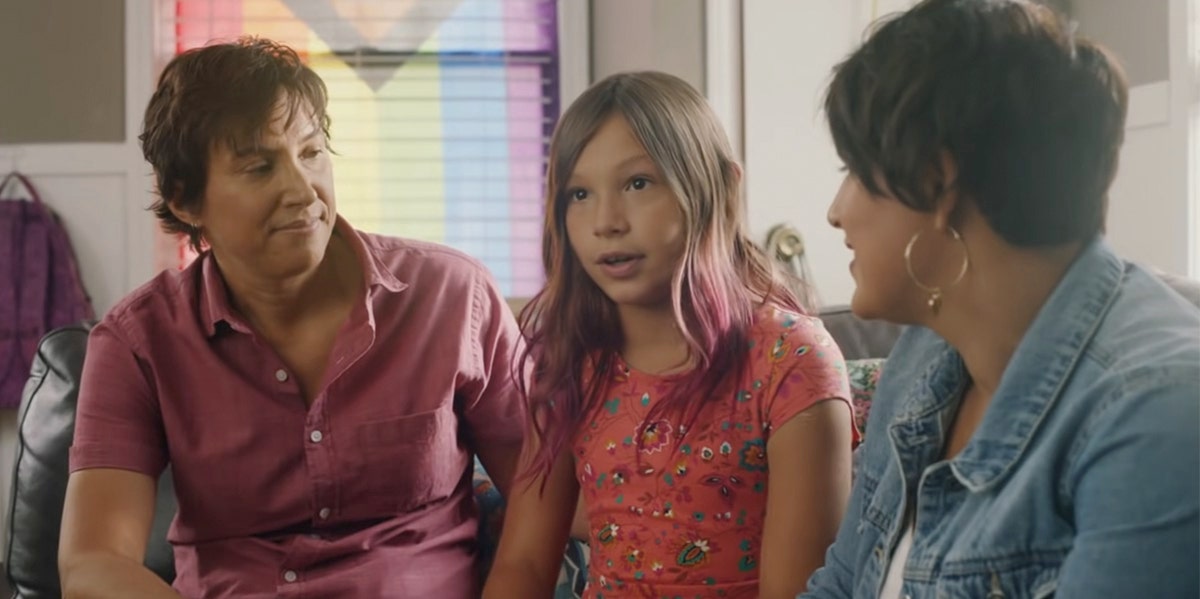Pantene Ad Shines Spotlight On Trans Representation
This Pantene ad is a rare example of fair and accurate trans representation.
 Pantene / Youtube
Pantene / Youtube In mid-March, international hair care company Pantene launched an advertisement that featured a 12-year-old transgender girl.
The ad drew praise for supporting trans visibility, but gender-diverse representation in advertising still has a long way to go, particularly centering transgender kids.
Pantene's video came out on March 15, 2021, and centered around Sawyer, a young trans girl being raised by lesbian mothers Ellie and Ashley.
It opens with onscreen text, reading, “For LGBTQ kids, hair is more than how you look. It’s how you are seen.”
Ashley discusses her daughter’s trans identity, saying that Sawyer’s gender expression is vital to who she is.
“I remember the first time she was out in the community wearing the clothing she wanted, and her hair, and she kind of was herself,” Ashley says. “And that was the first day where I saw her.”
The family’s testimonials are interspersed with brightly lit footage of Sawyer brushing and styling her long brown hair with dip-dyed pink ends.
“Hair has been a big part of her transition,” Ashley reveals. “Once she told us that she identified as a girl, she immediately wanted to grow her hair out.”
Sawyer says that styling her appearance to match her identity “made me feel good and confident, and it made my insides match my outsides.”
“My advice is just be yourself,” Sawyer informs her audience. “Don’t let anybody tell you who you are.”
The clip is part of a recent campaign by Patene in partnership with FamilyEquality.org, that foregrounds authentic and positive LGBTQ+ representation.
Sawyer’s ad prompted a frenzy of online criticism.
Social media users accused the company of everything from “pandering” to “child abuse,” showing just how far much of our society is from trans acceptance.
Pantene doubled down on their message in response, tweeting that "transphobia has no place in our world or on our feed."
A Pantene representative told reporters that the campaign was part of “an effort to drive awareness, education, and positive change for the LGBTQ-adoptive community.”
The company also donated 100 thousand dollars to Family Equality, backing up their messaging with financial support for LGBTQ+ families.
“It has been a tough year,” said the representative, “but it has also been a year where family and connection is more important than ever. That’s why we felt it was so important to drive awareness, education, and positive change around family equality for all.”
Other advertising campaigns featuring LGBTQ+ individuals have been criticized for insensitivity and tokenism, and representation for transgender individuals is still controversial and rare.
Community Marketing Inc. conducted a 2019 survey in which 74 percent of LGBTQ+ consumers said they were more likely to support companies that were actively trans-inclusive. Such data provides an incentive for brands to market to trans people regardless of their actual stance on the issue.
A variety of brands have engaged on the topic, but commonly half-baked messaging led viewers to question whether they genuinely cared about visibility or simply wanted to sell more products.
Starbucks was praised in 2019 for an advertisement centered around a trans man, but their video is still one of the few examples of clear and strong transgender representation in advertising.
Accurate and authentic portrayals of trans people are important to normalizing gender diversity, but media portrayals are often problematic.
A study on transgender representation in film and TV from 2002-2012, conducted by the Gay and Lesbian Alliance Against Defamation (GLAAD), found that trans characters were disproportionately cast as either “victims” or “villains.”
The organization’s findings also reported that “anti-transgender slurs, language, and dialogue” were present in nearly two-thirds of the studied footage.
Such narratives contribute to normalizing prejudice towards trans people, a demographic against whom harmful rhetoric is often leveled and violence is already devastatingly common.
GLAAD President Herndon Graddick noted that “media has a history of telling the world a story that transgender people are always victims or villains, instead of true depictions that show the transgender community as citizens worthy of equality and respect.”
“We hope television networks will think about what they can do to combat ignorance by improving their depictions of trans people,” Graddick said.
Pantene’s ad was a true story that focused on individuality, acceptance, and love – the kind of visibility that is vital for members of the transgender community.
Although trans representation and acceptance are not yet as prevalent in mainstream society as they should be, Pantene’s decision to share Sawyer’s sweet story seems to be a step in the right direction.
Hopefully, other brands and media will follow their lead.
Allie McGlone is a writer who covers a variety of topics for YourTango, including pop culture and entertainment.

